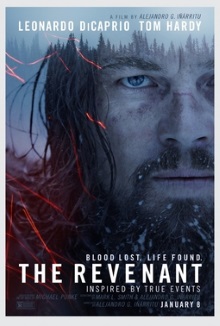
The Revenant is way too high profile a release to miss watching. It won a slew of awards, it was directed by Alejandro G. Iñárritu who deserves plenty of goodwill for Birdman and it has at least one scene that is now so iconic that its fame eclipses that of the film itself. Personally however I wasn’t too keen about the subject of the film which seemed to yet another survival in the wilderness story with an actor, Leonardo DiCaprio, who doesn’t seem altogether together suited to the role.
DiCaprio plays Hugh Glass, a guide who is accompanying a group of trappers. His half-Pawnee son Hawk is a member of the group and they are attacked by the Arikara, a tribe who are hostile to both Americans and the Pawnee. They decide to abandon their fur pelts and flee to the safety of Fort Kiowa but along the way Glass is attacked and badly mauled by a grizzly bear. Convinced that Glass will soon die, the captain leaves behind two men, Fitzgerald and Bridger along with Hawk, and charge them with taking care of Glass for as long as necessary and to properly bury him afterwards. Meanwhile the rest of the group travel onward. But as Glass continues to stubbornly cling on to life, Fitzgerald becomes increasingly nervous that the Arikara will catch up them. He tries to mercy kill Glass but is caught by Hawk who is in turn murdered. As you might expect this gives Glass a mighty strong motivation to not only survive but to chase down Fitzgerald and exact his vengeance.
There’s no denying that The Revenant is a gorgeous and technically flawless film. Everything from the ripples in the crystal clear water to the billowing smoke in the air is crisp and detailed. You can almost count the individual hairs on the gigantic bear pelt that Glass wears. Iñárritu also takes great delight in including stunning shots that are meant to blow the audience away. There are the requisite wide angle shots of fantastic scenery of course, but also things like an avalanche rumbling in the distance, a herd of stampeding buffalo kicking up snow and dust, and an intriguing shot of a half-demolished church bell tower. These are mostly things that you’ve seen before but the technical acumen required to get images of this quality is impressive nevertheless.
Also notable is the level of violence in the film. The large scale battles are par for the course but the individual fights, including the famous bear scene, have a level of goriness that is shocking even to inured audiences. You can see every cut and thrust, every spurt of blood and most of all even after you think a combatant has had enough, they go on and on to both receive and dish out even more wounds. Glass is in effect a glutton for punishment throughout the whole film and it sometimes feels as if this is an exercise in putting him through every kind of physical trauma the filmmakers can think of. I guess some audiences might get some kind of visceral thrill from it but I find little appeal in torture for the sake of torture.
Unfortunately, visuals aside, the film is soulless and just bland. The opening scene makes for a good case in point. It places the audience right in the middle of the action through terrific camera work and is obviously patterned after the beach landing scene of Saving Private Ryan. Yet there’s no emotion in the scene. Characters die left and right, but since we don’t know them we feel nothing for their deaths. It isn’t even clear which side we should be rooting for. We’re obviously led to view the scene through the eyes of the Americans, yet the same time we know for a fact that they are interlopers into the lands of the Native Americans, out to make a profit from killing and skinning thousands of animals. The disconnect between the brutality of the action and any sense of whether or not this means anything at all gives the scene something of a videogame feeling. It’s cool but ultimately hollow.
Much the same can be said of the rest of the film. Glass’ flashbacks and visions serve nothing and have no pay-off. We never even learn the circumstances of his Pawnee wife’s death or the consequences for Glass himself. By continually showing scenes of his wife’s spirit, the film is trying to tell us how much he loves her. Instead, it should be showing scenes of them being happy together if the wife is to be a real character. Then there’s the awfulness of the plot. The Arikara are out hunting for blood in force because someone kidnapped their chief’s daughter. They sell animal pelts to the French to get horses to use in the hunt and eventually it turns out that it was the French who were the kidnappers. How does that even make sense? The captain sends out a whole posse to search for survivors but when they realize that Fitzgerald has run away with apparently almost all of their money, only two people set out of the camp to chase him down?
Birdman was a great film not just because of its eclectic style and its tricks with the camera, but also because it has interesting things to say about its characters. None of that insight into human nature is in evidence here and the characters essentially have no development. For this film, Iñárritu appears to be entirely focused on perfecting the visuals to the detriment of everything else. This makes The Revenant pretty and entertaining enough but it’s a terrible disappointment from a director who has shown that he is capable of so much more.